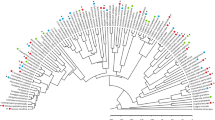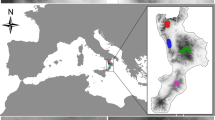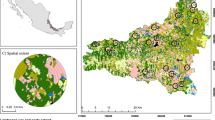Abstract
An understanding of spatial patterns of plant species diversity and the factors that drive those patterns is critical for the development of appropriate biodiversity management in forest ecosystems. We studied the spatial organization of plant species in human-modified and managed oak forests (primarily, Quercus faginea) in the Central Pre-Pyrenees, Spain. To test whether plant community assemblages varied non-randomly across the spatial scales, we used multiplicative diversity partitioning based on a nested hierarchical design of three increasingly coarser spatial scales (transect, stand, region). To quantify the importance of the structural, spatial, and topographical characteristics of stands in patterning plant species assemblages and identify the determinants of plant diversity patterns, we used canonical ordination. We observed a high contribution of β-diversity to total γ-diversity and found β-diversity to be higher and α-diversity to be lower than expected by random distributions of individuals at different spatial scales. Results, however, partly depended on the weighting of rare and abundant species. Variables expressing the historical management intensities of the stand such as mean stand age, the abundance of the dominant tree species (Q. faginea), age structure of the stand, and stand size were the main factors that explained the compositional variation in plant communities. The results indicate that (1) the structural, spatial, and topographical characteristics of the forest stands have the greatest effect on diversity patterns, (2) forests in landscapes that have different land use histories are environmentally heterogeneous and, therefore, can experience high levels of compositional differentiation, even at local scales (e.g., within the same stand). Maintaining habitat heterogeneity at multiple spatial scales should be considered in the development of management plans for enhancing plant diversity and related functions in human-altered forests.





Similar content being viewed by others
References
Aavik T, Püssa K, Roosaluste E, Moora M (2009) Vegetation change in boreonemoral forest during succession: trends in species composition, richness and differentiation diversity. Ann Bot Fennici 46:326–335
Alados CL, Navarro T, Komac B et al (2009) Do vegetation patch spatial patterns disrupt the spatial organization of plant species? Ecol Complex 6:197–207. doi:10.1016/j.ecocom.2008.10.015
Arroyo-Rodríguez V, Rös M, Escobar F et al (2013) Plant β-diversity in fragmented rain forests: testing floristic homogenization and differentiation hypotheses. J Ecol 101:1449–1458. doi:10.1111/1365-2745.12153
Aubert M, Bureau F, Alard D, Bardat J (2004) Effect of tree mixture on the humic epipedon and vegetation diversity in managed beech forests (Normandy, France). Can J For Res 248:233–248. doi:10.1139/X03-205
Baselga A (2010) Partitioning the turnover and nestedness components of beta diversity. Glob Ecol Biogeogr 19:134–143. doi:10.1111/j.1466-8238.2009.00490.x
Baselga A, Orme CDL (2012) Betapart: an R package for the study of beta diversity. Methods Ecol Evol. doi:10.1111/j.2041-210X.2012.00224.x
Berhane A, Totland Ø, Moe SR (2013) Woody plant assemblages in isolated forest patches in a semiarid agricultural matrix. Biodivers Conserv 22:2519–2535. doi:10.1007/s10531-013-0534-0
Borcard D, Gillet F, Legendre P (2011) Numerical ecology with R. Spriger, New York
Castroviejo S et al. 1986-2012. Flora Ibérica. vols 1–8, 10–15, 17–18, 21. Real Jardin Botanico, Madrid
Chandy S, Gibson DJ, Robertson PA (2006) Additive partitioning of diversity across hierarchical spatial scales in a forested landscape. J Appl Ecol 43:792–801. doi:10.1111/j.1365-2664.2006.01178.x
Chao A, Chiu C-H, Hsieh TC (2012) Proposing a resolution to debates on diversity partitioning. Ecology 93:2037–2051
Chávez V, Macdonald SE (2012) Partitioning vascular understory diversity in mixedwood boreal forests: the importance of mixed canopies for diversity conservation. For Ecol Manage 271:19–26. doi:10.1016/j.foreco.2011.12.038
Chazdon RL (2008) Beyond deforestation: restoring forests and ecosystem services on degraded lands. Science 80(320):1458–1460. doi:10.1126/science.1155365
Chazdon RL, Peres CA, Dent D et al (2009) The potential for species conservation in tropical secondary forests. Conserv Biol 23:1406–1417. doi:10.1111/j.1523-1739.2009.01338.x
CINTA (2013) Centro de Información Territorial de Aragón. http://sitar.aragon.es
Cottam C, Curtis JT (1956) The use of distance measures in phytosociological sampling. Ecology 37:451–460
Crist T, Veech J, Gering J, Summerville K (2003) Partitioning species diversity across landscapes and regions: a hierarchical analysis of α, β, and γ diversity. Am Nat 162:734–743. doi:10.1086/378901
Declerck SAJ, Coronel JS, Legendre P, Brendonck L (2011) Scale dependency of processes structuring metacommunities of cladocerans in temporary pools of High-Andes wetlands. Ecography (Cop) 34:296–305. doi:10.1111/j.1600-0587.2010.06462.x
Devictor V, Mouillot D, Meynard C et al (2010) Spatial mismatch and congruence between taxonomic, phylogenetic and functional diversity: the need for integrative conservation strategies in a changing world. Ecol Lett 13:1030–1040. doi:10.1111/j.1461-0248.2010.01493.x
Dorrepaal E (2007) Are plant growth-form-based classifications useful in predicting northern ecosystem carbon cycling feedbacks to climate change? J Ecol 95:1167–1180. doi:10.1111/j.1365-2745.2007.01294.x
ESRI (2013) ArcMap 10.1 Environmental Systems Research Institute Inc.
Fahey RT, Puettmann KJ (2007) Ground-layer disturbance and initial conditions influence gap partitioning of understorey vegetation. J Ecol 95:1098–1109. doi:10.1111/j.1365-2745.2007.01283.x
Flinn KM, Vellend M (2005) Recovery of forest plant communities in post-agricultural landscapes. Front Ecol Environ 3:243–250
Goodall DW (1952) Some considerations in the use of point quadrats for the analysis of vegetation. Aust J Biol Sci 5:1–41. doi:10.1071/BI9520001
Gossner MM, Getzin S, Lange M et al (2013) The importance of heterogeneity revisited from a multiscale and multitaxa approach. Biol Conserv 166:212–220. doi:10.1016/j.biocon.2013.06.033
Härdtle W, von Oheimb G, Westphal C (2003) The effects of light and soil conditions on the species richness of the ground vegetation of deciduous forests in northern Germany (Schleswig–Holstein). For Ecol Manage 182:327–338. doi:10.1016/S0378-1127(03)00091-4
Hart SA, Chen HYH (2006) Understory vegetation dynamics of North American boreal forests. CRC Crit Rev Plant Sci 25:381–397. doi:10.1080/07352680600819286
Hermy M, Verheyen K (2007) Legacies of the past in the present-day forest biodiversity: a review of past land-use effects on forest plant species composition and diversity. Ecol Res 22:361–371. doi:10.1007/s11284-007-0354-3
Jost L (2006) Entropy and diversity. Oikos 113:363–375. doi:10.1111/j.2006.0030-1299.14714.x
Jost L (2007) Partitioning diversity into independent alpha and beta components. Ecology 88:2427–2439. doi:10.1890/06-1736.1
Jost L (2010) Independence of alpha and beta diversities. Ecology 91:1969–1974
Kouba Y, Alados CL (2011) Spatio-temporal dynamics of Quercus faginea forests in the Spanish Central Pre-Pyrenees. Eur J For Res 131:369–379. doi:10.1007/s10342-011-0509-1
Kouba Y, Camarero JJ, Alados CL (2012) Roles of land-use and climate change on the establishment and regeneration dynamics of Mediterranean semi-deciduous oak forests. For Ecol Manage 274:143–150. doi:10.1016/j.foreco.2012.02.033
Lasanta T, Vicente-serrano S, Cuadratprats J (2005) Mountain Mediterranean landscape evolution caused by the abandonment of traditional primary activities: a study of the Spanish Central Pyrenees. Appl Geogr 25:47–65. doi:10.1016/j.apgeog.2004.11.001
Lavorel S, McIntyre S, Landsberg J, Forbes TDA (1997) Plant functional classifications: from general groups to specific groups based on response to disturbance. Trends Ecol Evol 12:474–478. doi:10.1016/S0169-5347(97)01219-6
Legendre P, Gallagher ED (2001) Ecologically meaningful transformations for ordination of species data 2001:271–280. doi:10.1007/s004420100716
Legendre P, Legendre L (2012) Numerical ecology, 3rd edn. Elsevier, New York
Loidi J, Herrera M (1990) The Quercus pubescens and Quercus faginea forests in the Basque Country (Spain): distribution and typology in relation to climatic factors. Vegetation 90:81–92
Lomba A, Vicente J, Moreira F, Honrado J (2011) Effects of multiple factors on plant diversity of forest fragments in intensive farmland of Northern Portugal. For Ecol Manage 262:2219–2228. doi:10.1016/j.foreco.2011.08.014
MAGMARA (2013) Tercer Inventario Forestal Nacional (IFN3) 1:50 000. Madrid, Spain
Melo FPL, Arroyo-Rodríguez V, Fahrig L et al (2013) On the hope for biodiversity-friendly tropical landscapes. Trends Ecol Evol 28:462–468. doi:10.1016/j.tree.2013.01.001
Oksanen J, F. Guillaume Blanchet RK, Legendre P et al (2013) Vegan: Community Ecology Package. R package version 2.0-7
R Development Core Team (2013) R: A language and environment for statistical computing. R foundation for statistical computing, Vienna, Austria. ISBN3–900051–07–0. http://www.R-project.org
Sabatini FM, Burrascano S, Tuomisto H, Blasi C (2014) Ground layer plant species turnover and Beta diversity in southern-European old-growth forests. PLoS ONE 9:e95244. doi:10.1371/journal.pone.0095244
Sancho M, Fernández P, Albertos S, Gil L (1998) Regiones de procedencia de Quercus pyrenaica Willd. Quercus faginea Lam. Quercus canariensis Willd. OAPN, Madrid
Scheiner SM (2012) A metric of biodiversity that integrates abundance, phylogeny, and function. Oikos 121:1191–1202. doi:10.1111/j.1600-0706.2012.20607.x
Sciama D, Augusto L, Dupouey J-L et al (2009) Floristic and ecological differences between recent and ancient forests growing on non-acidic soils. For Ecol Manage 258:600–608. doi:10.1016/j.foreco.2009.04.027
Vicente-serrano SM, Lasanta T, Gracia C (2010) Agricultural and forest meteorology aridification determines changes in forest growth in Pinus halepensis forests under semiarid Mediterranean climate conditions. Agric For Meteorol 150:614–628. doi:10.1016/j.agrformet.2010.02.002
Vockenhuber EA, Scherber C, Langenbruch C et al (2011) Tree diversity and environmental context predict herb species richness and cover in Germany’s largest connected deciduous forest. Perspect Plant Ecol Evol Syst 13:111–119. doi:10.1016/j.ppees.2011.02.004
Whittaker RH (1972) Evolution and measurement of species diversity. Taxon 21:213–251
Acknowledgments
We thank Arben Q. Alla, Gabriel Sangüesa-Barreda, Guillermo C. Bueno, Benjamin Komac, Maite Gartzia, Hugo Saiz, and Paloma Nuche for assistance in the field. Y.K. was funded by a MAEC-AECID grant from the Spanish Agency for International Cooperation and Development, and A.F. was supported by a JAE-doc postdoctoral contract from the framework “Junta para la Ampliación de Estudios” (Spanish Ministry of Economy and Competitiveness), co-financed by the European Social Fund. This study was part of the research project CGL2011-27259 (Spanish Ministry of Economy and Competitiveness and Innovation) co-financed by the FEDER.
Author information
Authors and Affiliations
Corresponding author
Additional information
Communicated by M. Del Rio.
Appendix
Appendix
species richness (Hill Index with exponent q = 0) (a) and exponential of Shannon entropy (Hill index with exponent q = 1) (b) for plant ecological groups found in the Q. faginea forest stands in the Central Pre-Pyrenees, Spain. Boxes depict the 25th and 75th percentiles, and whiskers represent the 5th and 95th percentiles
Rights and permissions
About this article
Cite this article
Kouba, Y., Martínez-García, F., de Frutos, Á. et al. Plant β-diversity in human-altered forest ecosystems: the importance of the structural, spatial, and topographical characteristics of stands in patterning plant species assemblages. Eur J Forest Res 133, 1057–1072 (2014). https://doi.org/10.1007/s10342-014-0822-6
Received:
Revised:
Accepted:
Published:
Issue Date:
DOI: https://doi.org/10.1007/s10342-014-0822-6





